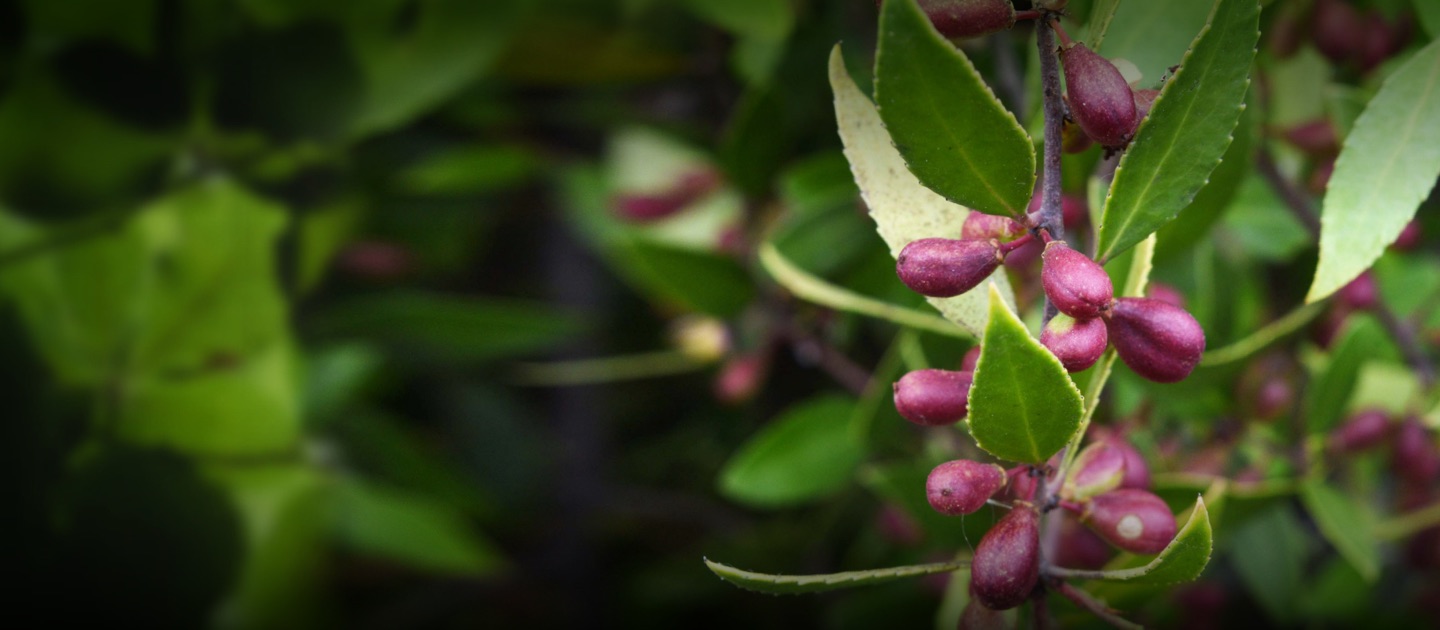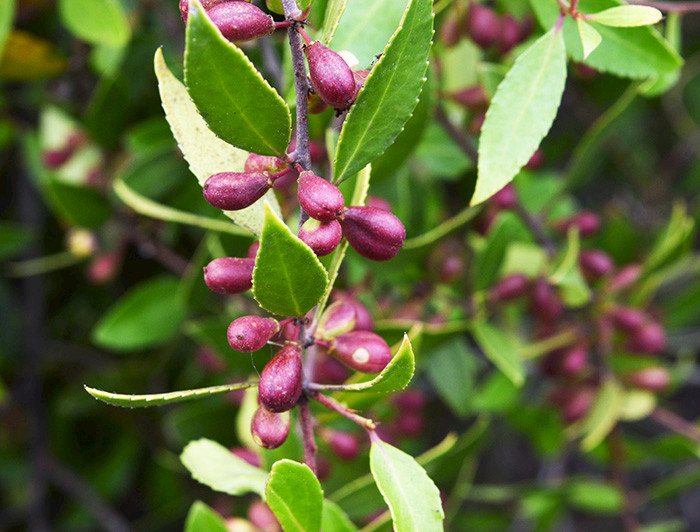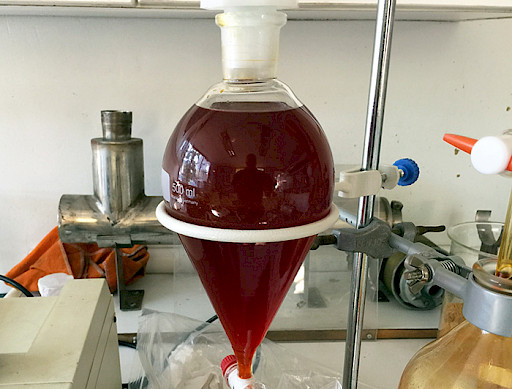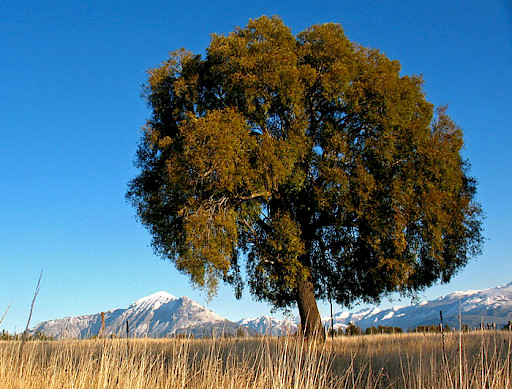
The Rediscovery of Mayten Seed Oil
The unique characteristics of this tree motivated a group of scientists from Universidad Católica and CAPES to study the properties of the oil extracted from the seeds.

photo_camera The oleic and linoleic acid content of Mayten seed oil is higher than that of most commercial oils used for human consumption. (Ricardo Quero/Flickr)
Mayten is an ornamental tree found in gardens, parks, and squares. With graceful leaves and deep red seeds, it is highly adaptable to different environmental and soil conditions. These characteristics, plus the oiliness of its seeds, motivated a group of scientists from Universidad Católica and CAPES to study the properties of the oil extracted from the seeds of this tree, yielding promising results.
Mayten branch with seeds "The most important findings are that its oleic and linoleic acid content is higher than most commercial oils used for human consumption, which are important for the human diet. In addition, it has a high antioxidant capacity," said Professor Rosanna Ginocchio about the mayten seeds.
The mayten, or Maytenus Boaria is an evergreen tree native to Chile, Argentina, Peru and Brazil, growing up to 15 meters tall. The plant is highly adaptable to various environmental conditions, including precipitation levels, humidity, soil pH, and water supply. This plant has a broad geographical distribution in our country, occurring from Coquimbo to Aysén, and from the coastal mountains to the Andes.
A couple of centuries ago, according to the chronicles of Benjamín Vicuña Mackenna, the population of Santiago consumed an oil produced from mayten seeds. This fact caught the attention of Rosanna Ginocchio, professor at the Faculty of Agronomy and Forestry Engineering, and researcher at the Center for Applied Ecology and Sustainability (CAPES). With her team they discovered that when the seeds of this tree were kept in paper cartridges, they quickly became oily, which led them to try to determine if the tree could be planted on mining tailings in order to rehabilitate the soil and produce a nontraditional product at the same time.
Although the mayten turned out not to be the tree they were looking for, they continued their research in the hope of obtaining oil from its seeds and learning about its properties. "Later, through an internal UC Chile interdisciplinary fund, in partnership with César Sáez, a colleague from UC Engineering, we began investigating the extraction efficiency of mayten seed oil using various methods, explained Professor Ginocchio."The results we achieved were very promising. Through this same initiative, we explored the potential uses of the oil by performing standardized chemical analyses.In addition, we partnered with Ady Giordano, a colleague from the School of Chemistry, to further the analyses.”
The results related to the nutritional value of mayten seed oil were published in the MDPI Foods magazine under the title “Mayten Tree Seed Oil: Nutritional Value Evaluation According to Antioxidant Capacity and Bioactive Properties.”
Study for a Seed

Vegetable oils are extracted from the seeds and fruits of plants. In today's market, most vegetable oils derived from seeds are obtained from soybeans, sunflowers, canola, flax, linseeds, oil palm nuts, castor oil, peanuts, cotton seeds, and shea nuts.
However, it is known that there are plant species that grow in harsh environmental conditions, such as arid and semi-arid climates or nutrient-poor soils, which also produce oilseeds. For Professor Ginocchio, mayten seeds represented a real possibility for expanding vegetable oil production in regions where traditional crops are not feasible.
To produce the oil, the research team collected fruit from mayten trees of different origins. Seeds were separated by hand, allowed to air dry and stored at 5ºC. They were then grounded and, with the aid of solvents, their oil was extracted, achieving a yield of 61.8%, higher than that of the oils extracted from sunflower, sesame and pumpkin seeds, a percentage that could still be improved with other extraction procedures.
As for its chemical composition, this oil was shown to be rich in oleic and linoleic acid. Oleic acid is an omega-9 monounsaturated fatty acid with anti-thrombosis properties and other bioactive components, which has been used in cosmetic and pharmacological applications. The oleic acid content of the oil was higher than that found in sunflower oil, similar to that of soybean oil and lower than that of palm oil. In terms of linoleic acid, it is an omega-6 fatty acid and is known as a precursor of other anti-inflammatory lipid mediators, the content in mayten oil was higher than in olive oil and palm oil.
The extracted oil has a reddish-orange color due to its high carotene content. 70% corresponds to β-carotene, which is a precursor of vitamin A and plays an important role in the prevention of cataracts and other eye diseases. It was also found that the antioxidant capacity of mayten seed oil is three times higher than that of canola oil and 15 times higher than that of sunflower, rice bran and olive oils.
As explained by Professor Ginnochio: "The most important findings are that its oleic and linoleic acid content is higher than most commercial oils for human consumption, which are relevant to the human diet. In addition, it has a high antioxidant capacity, due to its high content of carotenes and polyphenols, something that is also relevant for human nutrition.”
From Ornamental Tree to Oil Producer

The mayten has no conservation problems. It is a native tree in countries of the South American cone, where it is a secondary species of the forests. Its distribution in our country is wide (28º to 45º south latitude), so it adapts to different environments well. Although the researcher indicated that "its natural abundance has been decreasing, it is a species that has had an ornamental use, not only in the country, but also in other countries such as England and New Zealand, due to the pendular character of its branches."
Is it viable to cultivate this tree for commercial extraction of its oil? As the professor explained, mayten is not a naturalized species that is being massively cultivated for this purpose. “It is a species of ornamental use, quite valued for that purpose. Therefore, some aspects of its biology and ecology are known. Our next step will be to assess the feasibility of establishing commercial crops of this species for seed and oil production," she said.
In the study, it was concluded that mayten seed oil would be an interesting alternative to other vegetable oils for human consumption, because it could be produced, with good yields, in areas affected by climate change.
This oil could be considered as a functional food, a carotenoid supplement or an antioxidant additive ingredient for the food industry. It is a rediscovery of an old acquaintance of the inhabitants of the 21st century.


